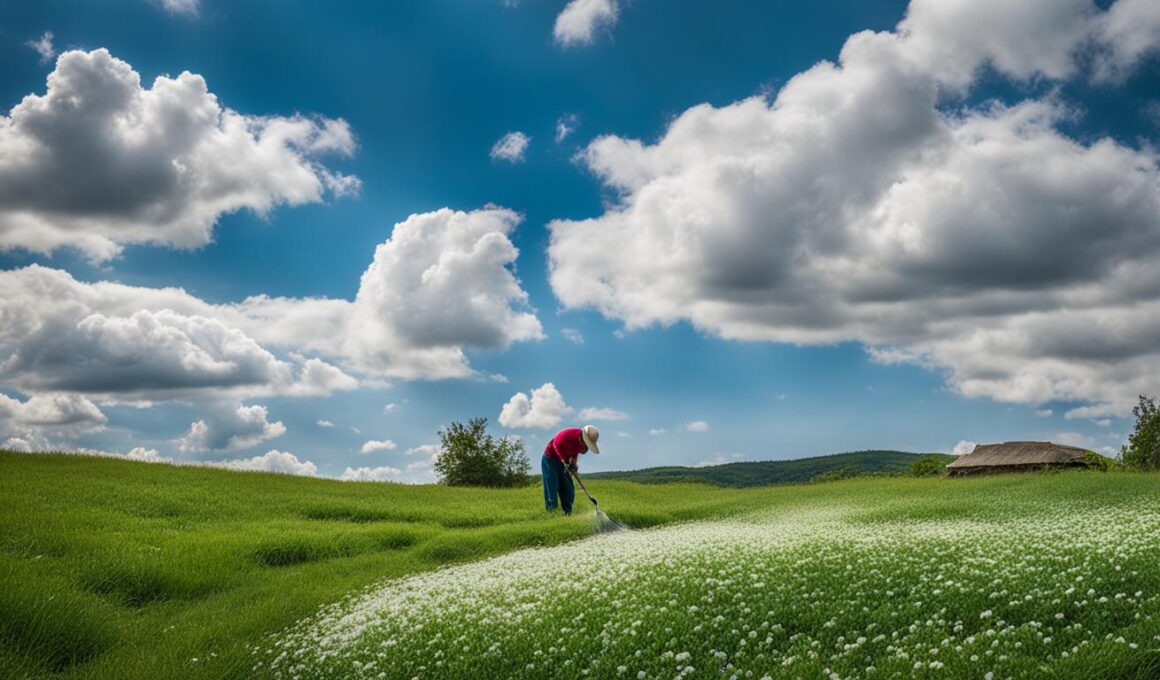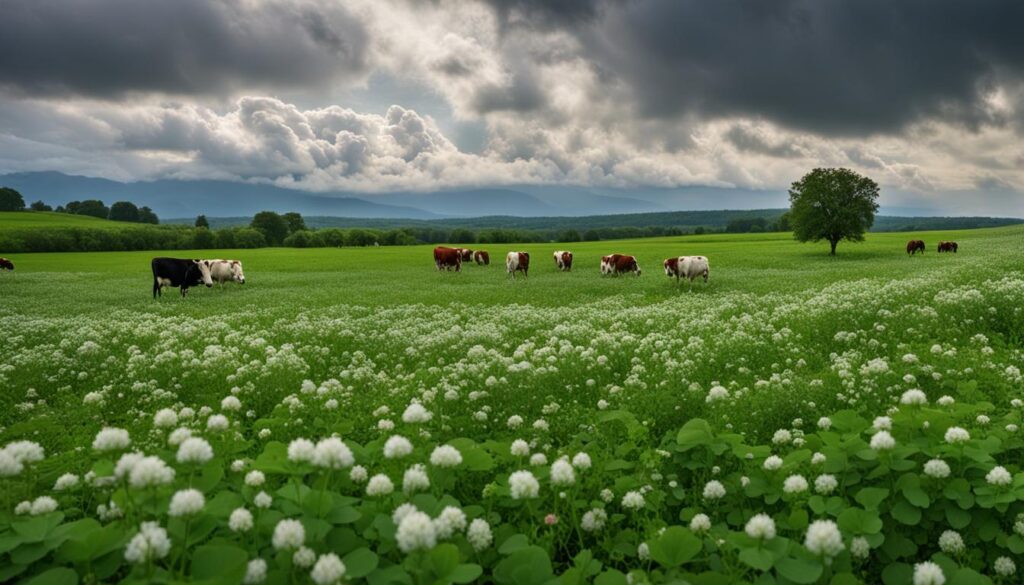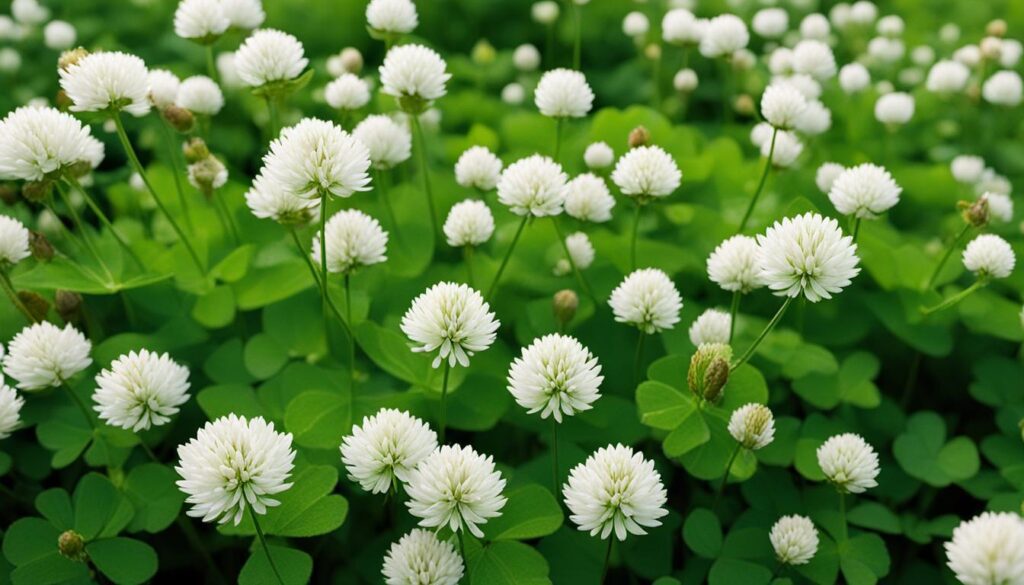If you’re looking to add white clover to your garden or lawn, it’s important to know the optimal timing for planting. The success of your white clover growth depends on getting the timing right. By planting white clover at the right time, you can ensure healthy and thriving plants.
So when is the best season for planting white clover? The ideal time to plant white clover is in late summer or early fall. This timing allows the clover to establish itself before the colder winter months. Planting in early fall gives the clover a chance to develop a strong root system and prepare for vigorous growth in the spring.
Why is late summer/early fall the best time to plant white clover? By this time, competing vegetation has started to slow down its growth. Planting after competing vegetation has been killed ensures that the white clover has a better chance of establishing itself without competition.
If you’re tilling or plowing the soil, it’s recommended to wait 4 to 6 weeks after tilling for new weeds to emerge. Once they appear, kill them before planting the white clover. This allows you to eliminate any potential competition from weeds.
If you prefer a no-till method, you can mow or burn off existing vegetation, spray an herbicide, and then seed the white clover. This method allows for quicker planting without disturbing the soil.
For smaller areas, you can kill off all living vegetation, rake the ground, scatter the white clover seeds, and keep the area moist until the seeds germinate and the clover is established.
By following these timing considerations and planting methods, you’ll set your white clover up for successful growth and enjoy its many benefits.
Characteristics of White Clover
White clover, characterized by its low-growing perennial nature, is a versatile plant that offers numerous benefits. Its trifoliate leaves create a unique visual appeal, while its spreading ability allows it to form dense mats across the soil. These mats are created through the development of roots on offshoots that come into contact with the ground, making white clover an excellent ground cover option.
While some may consider white clover as a weed, its characteristics make it highly valuable. One of its standout traits is its drought tolerance, which surpasses that of traditional turfgrass. This means that white clover can withstand periods of limited water availability, making it a resilient choice for your outdoor spaces.
In addition to its resilience in dry conditions, white clover offers the benefit of aerating the soil. As it spreads across the ground, the plant’s roots create small channels that improve soil structure and support better water infiltration.
One of the most appealing characteristics of white clover is its minimal care requirements. Unlike turfgrass that demands frequent mowing and maintenance, white clover only requires occasional trimming to keep it neat and tidy. This low-maintenance quality allows you to enjoy your outdoor spaces without the constant upkeep.
White clover is also known for its ability to withstand the effects of dog urine. Unlike turfgrass, which may become discolored or damaged, white clover remains resilient, making it an ideal choice for households with furry friends.
Overall, the characteristics of white clover make it a beneficial addition to any lawn or garden. From its low-growing perennial nature to its spreading ability, drought tolerance, and other advantages, white clover offers a range of benefits that can enhance the appearance and functionality of your outdoor spaces.
Planting and Care for White Clover
To ensure successful growth of white clover, it is essential to pay attention to planting and care techniques. Here are some important considerations when planting white clover:
Soil Requirements
White clover thrives in slightly acidic, well-drained soil with good drainage. It is important to choose a spot with partial to full sun exposure for optimal growth.
Propagation
White clover can be propagated through offshoots or easily grown from seed. If you choose to sow seeds, directly sow them in warm weather. Keep the area watered and moist to promote germination and establishment.
Watering
White clover requires regular watering, especially during dry periods. However, be cautious not to overwater, as excessive moisture may lead to rot or fungal diseases.
Care Tips
White clover is relatively low-maintenance and resistant to pests and diseases. However, due to its aggressive spreading nature, it is important to consider carefully before planting it in areas where it may take over.
By following these planting and care tips, you can ensure the successful growth and maintenance of white clover in your garden or lawn.
Uses and Benefits of White Clover
White clover, with its multitude of uses and benefits, is a highly versatile plant. Whether you’re looking to enhance forage options for livestock, promote wildlife habitat, control erosion, or beautify your landscape, white clover delivers on all fronts.
One of the primary uses of white clover is as a valuable pasture legume. It provides highly palatable and nutritious forage for both livestock and wildlife. The abundance of protein and energy in white clover makes it an excellent choice for grazing animals, improving their overall health and productivity.
White clover also serves as an effective plant for stabilization on moist soils, making it an ideal option for erosion control. Its extensive root system helps prevent soil erosion, reducing the risk of runoff and soil loss. This characteristic makes white clover a natural choice for areas prone to erosion, such as streambanks or steep slopes.
In addition to its practical uses, white clover offers aesthetic benefits as well. It can be used as a ground cover in landscaping projects, adding a touch of beauty to gardens and lawns. The vibrant white flowers of the clover provide a stunning contrast against the greenery, creating visual interest.
Furthermore, white clover attracts various pollinators, including the essential honeybees. These diligent pollinators play a critical role in supporting plant reproduction and biodiversity. By planting white clover, you can help support the health and population of pollinators, contributing to the overall well-being of your ecosystem.
Whether you’re a farmer, a conservationist, or a homeowner looking to beautify your property, incorporating white clover into your landscape offers numerous benefits. Its use as forage, erosion control, wildlife habitat, and pollinator attractant make it a versatile and eco-friendly choice.
Adaptation and Distribution of White Clover
White clover, known for its adaptability and widespread distribution, thrives in cool, moist climates. It is best suited for clay and silt soils found in humid and irrigated areas. However, it can also grow successfully on sandy soils with a high water table or when provided with irrigation. Although white clover does not have deep roots, typically not exceeding 2 feet, it is well-adapted to shallow soils with adequate moisture.
White clover’s circumboreal distribution spans across various regions. Its origins can be traced back to Europe, and it has naturalized throughout Canada and the United States. With its ability to withstand diverse climatic conditions, white clover has become a familiar sight in many parts of the country.
White clover adapts and thrives in different environments, making it a versatile and resilient plant.
Management and Maintenance of White Clover
White clover is a versatile plant that requires proper management and maintenance for optimal growth and productivity.
When it comes to choosing a companion crop, white clover is often paired with forage grasses. This combination not only enhances the overall forage quality but also reduces the need for additional fertilizers. White clover has the unique ability to fix nitrogen from the atmosphere, which benefits the companion grasses and minimizes the need for nitrogen-based fertilization.
While white clover can derive nitrogen from the atmosphere, it requires other nutrients like phosphorus, potassium, and sulfur for optimal production. It’s important to ensure these nutrients are present in the soil to support the growth and development of white clover.
Grazing management is essential to maintain the desired clover percentage in pastures. Overgrazing can lead to a decrease in white clover abundance, while undergrazing can result in excessive growth and reduced forage quality. Regular monitoring and adjusting grazing intensity can help maintain a healthy balance and maximize the benefits of white clover in a grazing system.
White clover is susceptible to various diseases, insects, and pests. Control measures should be implemented to minimize potential problems. Regular inspection, prompt identification of issues, and targeted treatment can help mitigate the impact of pests and diseases on white clover.
Seed production is an important aspect of white clover management. Proper irrigation, pollination, and harvesting techniques can facilitate seed production and ensure a reliable seed supply for future planting.
To summarize, companion cropping, appropriate fertilization, strategic grazing management, proactive pest control, and effective seed production techniques are crucial for successful management and maintenance of white clover.
Varieties and Cultivars of White Clover
White clover comes in three general types: large, intermediate, and small. Each type has its own characteristics and recommended cultivars.
Large Type – “Ladino”
One of the recommended cultivars for the large type of white clover is “Ladino.” This variety is well-suited for certain regions and offers excellent performance when properly managed.
Intermediate Type – “Grassland Huia”
The intermediate type of white clover is represented by the cultivar “Grassland Huia.” This variety is specifically adapted to coastal areas and thrives in those environments.
Small Type – “New York” Wild White Clover
In the small type category, the “New York” wild white clover is a prominent cultivar. It is specially adapted to higher elevations and colder climates, making it suitable for those regions.
These varieties and cultivars offer different characteristics and are adapted to various climates and environments. Consider your specific needs and growing conditions when selecting the right white clover variety for your lawn or garden.
Can Planting White Clover Help Prevent Overgrowth in Lawns?
Planting white clover in lawns can actually banish clover from the lawn, as it competes with other plants for space and nutrients, preventing overgrowth. The dense nature of white clover helps to keep out invasive weeds and grasses, creating a healthier and more balanced lawn ecosystem.
Conclusion
In conclusion, white clover is a versatile and beneficial plant that can serve various purposes in your garden or lawn. Its low-maintenance nature and numerous advantages make it an excellent choice for homeowners who want to enhance their outdoor spaces. By understanding the optimal timing for planting, the characteristics of white clover, and its uses and benefits, you can successfully incorporate this plant into your landscape.
White clover’s ability to provide nutritious forage for livestock and wildlife, serve as an erosion control cover, attract pollinators like honeybees, and require minimal care are just a few of its key attributes. However, due to its aggressive spreading ability, careful consideration should be given before planting it in areas where it may take over. With proper planning and management, white clover can become a valuable addition to your outdoor environment.
Whether you’re looking to create a beautiful and environmentally-friendly lawn, establish a wildlife-friendly habitat, or enhance the aesthetics of your garden, white clover offers a range of benefits. Its drought tolerance, soil aerating capabilities, and resistance to pests make it a sustainable choice for homeowners across the United States. Consider incorporating white clover into your landscaping plans and enjoy the many rewards it has to offer.











